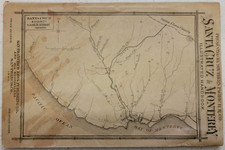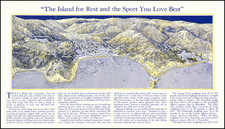Calipatria (Imperial County) in 1930
This fire insurance atlas of Calipatria, California, produced in March 1922 and updated in February 1930 by the Sanborn Map Company, provides an in-depth cartographic depiction of Calipatria's infrastructure, buildings, and fire protection facilities. The atlas contains seven detailed maps of the town, with annotations indicating the architectural, structural, and material makeup of buildings, as well as local protective measures against fires. At an elevation of 180 feet below sea level, Calipatria is the lowest incorporated city in the Western Hemisphere, and is notable for its proximity to the Salton Sea. The indexed maps offer a glimpse into the commercial and civic life of Calipatria during the 1920s, a town that had only recently been established in 1914.
In the 1920s, Calipatria, situated in the north part of Imperial County, was a relatively new settlement established primarily as an agricultural center. Located in one of the lowest regions of the United States, the town was part of the larger Imperial Valley area, a significant agricultural zone enabled by irrigation from the Colorado River. The town attracted farmers and laborers seeking to capitalize on the fertile soil and irrigation projects, contributing to a modest population increase during this decade. According to a 1919 promotional work on Imperial County, Calipatria's development was intially stymied by a corporation that owned alternate sections of land and refused to sell in small tracts, preventing other owners from developing the needed canals and irrigation improvements to make the place thrive. This finally changed when a syndicate bought the land and established a mutual water company, illustrating how Calipatria's growth was inherently tied to water management and technology put into place ca. 1920.
Several business and civic establishments are shown in the atlas, including the segregated Bonita Public School (for Mexican and African American students), California Wharf & Warehouse Company, Congregational Church, Globe Cotton Oil Mills, and the Southern Pacific Railroad Depot, among others, reflecting the diversity of the community. The construction material of each building, whether made of wood, brick, or fireproof materials, is denoted by a color: yellow for wood frame buildings; red for brick; blue for stone; gray for iron; and brown for "fire proof." A few buildings are noted as adobe structures.
Selection of structures and sites noted in the atlas include:
- Honey Extracting Plant
- Bonita Public School (Negro & Mexican)
- Kerckhoff Cuzner Mill & Lumber Co.
- Imperial Mill & Ginning Co.
- American States Water Co.
- Californian Hawaiian Milling Co.
- Southern Pacific Co.'s Employee's Quarters
The detailed annotations on water facilities, maintained by the American States Water Co, reflect the town's preparedness for firefighting. The descriptions provide a sense of scale and capability, from the extensive storage facilities to the sophisticated distribution methods. Similarly, insights into the local volunteer fire department, their equipment, and their readiness help underscore the challenges and constraints they faced. The boundaries for fire and city limits further demonstrate the municipality's commitment to safeguarding its populace and infrastructure.
Beyond a tool for assessing fire risks, the Sanborn Fire Insurance Atlas of Calipatria is a historical document that documents the town's architectural, industrial, and civic evolution during the early 20th century. Such specilized maps offer a wealth of building-level information about the area, and thus stand as a valuable resource for studying changes in urban environments. The precision and care with which it was created contribute greatly to its present value as a primary source for understanding the development of this small settlement near the Salton Sea.
Rarity
While any early 20th-century map of Calipatria would be scarce, the complete Sanborn Atlas for Calipatria is extremely rare in both the antiquarian market and within institutional confines. No copy of any issue is traced in OCLC, though California State Northridge lists 1916, 1922, 1930 and 1941 editions in the index of their Sanborns Atlas holdings. The Library of Congress has a digitized version of the 1922 iteration updated to 1941, but not the present edition updated to 1930.
The Sanborn Map Company, founded in the 1860s by Daniel Alfred Sanborn, is a renowned cartographic institution primarily recognized for its unparalleled fire insurance atlases. These atlases emerged as indispensable tools during the late 19th and early 20th centuries, portraying the evolution of urban America with unprecedented detail and precision. Charting both burgeoning metropolises and smaller municipalities, Sanborn's fire insurance maps provide a unique and illuminating perspective on the physical, economic, and social transformation of the nation during a period of intense urbanization and industrialization.
During the latter half of the 19th century, the United States witnessed an acceleration in urban growth. This shift from rural to urban living, bolstered by the advent of the Industrial Revolution, generated densely populated areas with a diverse array of architectural styles, materials, and infrastructure. In this context, the need for comprehensive maps that could illustrate the specifics of the built urban fabric became paramount, especially for insurance companies seeking to assess the risks associated with insuring individual properties. The Sanborn Map Company responded to this demand, creating elaborate maps that identified building materials, the purpose of structures, and even features like fire walls and sprinkler systems.
A standout feature of Sanborn's maps was their color-coding system, which allowed for a swift and clear differentiation between building materials—whether wood, brick, iron, or otherwise. This system, paired with the company's legends -- detailing everything from the width of streets to the locations of hydrants -- made these atlases an invaluable resource for insurance underwriters. By the turn of the 20th century, Sanborn maps covered thousands of cities and towns across the United States.
Beyond their utility to the insurance industry, the atlases produced by the Sanborn Map Company have, over time, become a treasured resource for historians, urban planners, preservationists, and environmental researchers. These maps have also been pivotal in brownfield research, shedding light on past industrial activities and potential contamination sites. They offer a window into the past, capturing the architectural, infrastructural, and environmental trends of various eras, and revealing the intricacies of a city's development. The very design of streets, the evolution of residential and commercial areas, and the rise and decline of certain industries can be traced through these maps.
Around 1960, Warren Buffett, then a burgeoning value investor, took a significant position in Sanborn Map Co., sinking 35% of his partnership's money into the company. Buffett was drawn to Sanborn's extensive map business, which he described as a virtual monopoly, as well as the company's valuable investment portfolio. While the cartographic aspect of Sanborn's business was diminishing in profitability due to technological advances introduced by competitors, Buffett recognized that the informational content of the maps had not been updated to electronic access, and was thus an undervalued asset for the company. His investment in Sanborn Map Co. is often presented as Case Study No. 1 in overviews of his value-oriented investment philosophy, which emphasized undervalued assets.
In sum, the Sanborn Map Company's fire insurance atlases are not merely maps; they are intricate tapestries of American urban history, detailing the nation's progression from the late 19th to the 20th century. Through their detailed renderings, these maps continue to serve as invaluable chronicles of the United States' urban transformation during a pivotal era.











![[ Walking on the Moon -- Apollo 15 Extra Vehicular Activity Atlas ] Hadley-Apennine Landing Site Apollo 15 - 1:12,500 and 1:25,000](https://storage.googleapis.com/raremaps/img/small/68099.jpg)



![[Santa Cruz / Holmes Lime Company] [H.T. Holmes Lot. Area 15 85/100 Acres.](https://storage.googleapis.com/raremaps/img/small/76542.jpg)
![(Sea Atlas of the Mediterranean) ['t Nieuw Groot Straets-Boeck Inhoudende de Middellandtsche Zee . . .] Nieuwe Water-Werelt, ofte Zee-Atlas. Verthoonende Alle gelegentheden der Zee-Custen. . .](https://storage.googleapis.com/raremaps/img/small/92441.jpg)